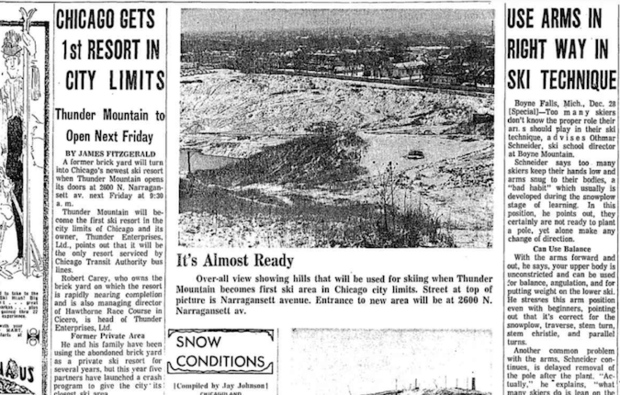BELMONT CRAGIN — For one fleeting moment in the city's history, Chicagoans didn't have to take a road trip to go downhill skiing.
What started as a defunct brick factory at the corner of Diversey Avenue and Narragansett Avenue spent a single year as "Thunder Mountain," a local ski resort that let visitors glide down a snow-covered mountain made of solid clay.
After the Carey family closed their long-running factory in 1960, patriarch Robert Carey saw a lucrative opportunity to re-tool the property, according to Illinois historian Neil Gale.
"The way the factory worked was that they'd dig a big hole on one side of the property and pile the clay on the other side, so you had this big mound that led down into a crater," Gale said. "So [Carey] figured it would be the perfect place for a ski resort."
The Careys launched "Thunder Enterprises" and divided the landscape into three different runs, each varying by difficulty, according to a Tribune article published on Dec. 29, 1967 to mark the slope's opening. At 285 feet, "Thunder Mountain" boasted the tallest vertical drop-off of any ski resort for 200 miles.

It was also, as Trib reporter James Fitzgerald noted, "the only resort serviced by Chicago Transit Authority bus lines."
Visitors paid $3.50 apiece for a full day's access to the slope, with an extra dollar for parking. Skiers grasped "rope tows" that pulled them to the top of the mound after each run, Gale said.
The owners planned to build chair lifts, reaching up from a "five-story chalet" including 125 motel units they planned to build on top of the former factory's kiln.
But those plans were never realized. A combination of light snowfall and weak interest in the mini-resort turned the project into a bust, forcing it to close after a single season.
"It would have been perfect one year earlier, after the great blizzard of 1967," Gale said, referring to a storm on Jan. 26 and 27 that dropped 23 inches of snow.
"But there just wasn't enough snow to bring it to full fruition, and they lost almost everything," he said.
The Carey family sold the property, and in 1978 a new developer leveled the ground and replaced it with the Brickyard Mall.
Today, the site is home to a block-sized strip mall that includes a Target superstore, a Lowe's Home Improvement store and a Jewel-Osco grocery. Signs still mark it as "The Brickyard."

The site of the former Carey Brick Factory, which was briefly transformed into "Thunder Mountain" ski resort in 1967 before being redeveloped as a strip mall. (DNAinfo/Alex Nitkin)




















